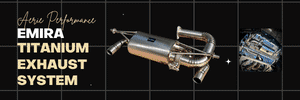According to Grok:
Key Differences Between the DCT in the Lotus Emira i4 and the Automatic in the Emira V6
The Lotus Emira i4 (inline-4 turbocharged engine) pairs exclusively with an 8-speed dual-clutch transmission (DCT) sourced from Mercedes-AMG, while the Emira V6 (supercharged V6 engine) offers a 6-speed torque-converter automatic (sourced from Toyota) as its automatic option (alongside a manual). These transmissions differ fundamentally in design, performance, and driving experience, reflecting the engines they’re tuned for. Below is a breakdown of the main differences:
1. Transmission Type and Design
• i4 DCT: A dual-clutch system with two separate clutches for odd and even gears, enabling pre-selection and near-instantaneous shifts (typically under 100ms). It’s electronically controlled with paddle shifters and lacks a traditional torque converter, providing a more direct, mechanical feel.
• V6 Automatic: A conventional torque-converter automatic using a fluid coupling to multiply torque and enable smooth, slip-free engagement. This design is more traditional and prioritizes refinement over razor-sharp precision.
2. Number of Gears
• i4 DCT: 8 forward gears, allowing finer progression for better fuel efficiency at highway speeds and more flexible ratios for performance. Gear ratios are approximately 15.94 (1st) down to 1.81 (8th), with a final drive of 3.79.
• V6 Automatic: 6 forward gears, which is adequate for the V6’s power delivery but results in wider-spaced ratios compared to the i4’s setup.
3. Shift Speed and Responsiveness
• i4 DCT: Faster shifts overall, ideal for track or aggressive driving, with launch control and no torque interruption during changes. However, some early reviews note occasional hesitation or “hunting” between gears in dynamic scenarios, and downshifts can feel less intuitive than in premium DCTs (e.g., Porsche PDK).
• V6 Automatic: Slower shifts (though improved with software updates, quicker than many traditional autos), with more noticeable torque converter slip during transitions. It’s smoother in everyday traffic but less engaging for spirited driving.
4. Driving Experience and Usability
• i4 DCT: More engaging for performance-oriented drivers, with quicker paddle responses and better low-end torque multiplication from the turbo engine (430 Nm peak). It’s easier in stop-start city driving (no clutch pedal) and offers a “racing-level” feel, but the gear selector requires a double-pull for Drive/Reverse, which some find fiddly.
• V6 Automatic: Smoother and more relaxed for grand touring, with the torque converter absorbing bumps in power delivery from the supercharged V6. It provides extra low-speed torque (up to 430 Nm vs. 420 Nm in manuals) but feels less connected, potentially detracting from the Emira’s raw sports-car ethos.
5. Weight and Efficiency Impact
• i4 DCT: Heavier unit (DCTs generally add ~20-30 kg more than torque converters), but the lighter i4 engine and aluminum subframe make the overall i4 Emira the lightest variant at ~1,405-1,446 kg. Better suited for efficiency with the turbo engine.
• V6 Automatic: Lighter transmission (~10-15 kg less than the DCT), but the heavier V6 pushes curb weight to ~1,458 kg. The setup favors the V6’s broader powerband over outright efficiency.
6. Reliability, Maintenance, and Cost
• i4 DCT: Proven in Mercedes-AMG models (e.g., A45), but Lotus has limited tuning access (arrives sealed from AMG). Potential for higher maintenance costs due to complexity; long-term reliability in the Emira is unproven.
• V6 Automatic: Borrowed from Toyota (similar to Camry/Evora units), it’s battle-tested with excellent durability and lower servicing needs. More cost-effective overall, though resale may favor manuals.
In summary, the i4’s DCT emphasizes quick, precise performance and modern usability, making it the better choice for track days or daily driving, while the V6’s automatic prioritizes smoothness and reliability for a more GT-like experience. If engine sound and character matter (V6’s supercharger whine vs. i4’s turbo whoosh), that could tip the scales—many enthusiasts prefer the V6 for its analog feel despite the transmission. For hands-on comparisons, test drives are recommended, as the DCT elevates the i4’s agility but can’t fully match the V6’s visceral appeal.







